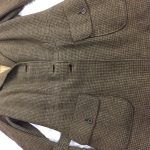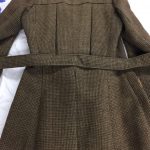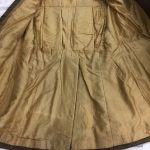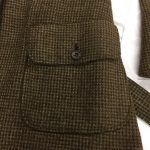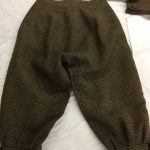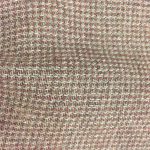Last Wednesday I went back to the Robert and Penny Fox Historic Costume Collection at Drexel University to visit my object. I started this visit by making general observations, then made more observations from a closer perspective. This two-piece tweed suit appears to be tightly woven from olive green, tan, and brown wool. The fabric itself resembles a homemade texture, though was probably woven by machine. The seams and pockets look as if they were sewn by machine as well. The jacket features two pockets in the front fastened with brown circular buttons, as well as a sewn in belt that ties in the front to accentuate the waistline. The back of the jacket is pleated and the collar resembles a men’s sports jacket. Each sleeve has three small brown buttons located on the wrist area. The interior of the jacket is lined with a tan cotton fabric with machine made stitching. The length of the coat from center back is 32 inches and the waist measures 36 inches with the belt untied. The sleeves measure 23.5 inches from the top shoulder. The two front pockets are both 7.25 inches deep and 6.75 inches wide.
The pants are made from the same type of fabric and measure 27 inches in the waist and 38 inches in the hip. The length of the pants is 29 inches from center to bottom. The pants look like they are only supposed to come down to the mid calf region and have small buckles on each leg to tighten around a stocking.There is also a tag on the inside of the inside of the pants that identifies the manufacturer, P.N. Degerberg of 1621 Chestnut Street, Philadelphia. Fortunately enough, the tag also identifies an owner, Mrs. Stanley Bright. It also turns out that the donor of the suit has the same last name. Though this is a woman’s suit, it has a very masculine look, especially for the year 1919, which is also written on the tag. Based on what I already know about this object, this suit was created for a woman to participate in some type of sport. Though I do not know yet which sport Mrs. Bright was participating in, it seems as if this outfit was designed for better range of movement. I am particularly intrigued by the story behind the suit, as it was not yet common or widely accepted for women to wear pants.

